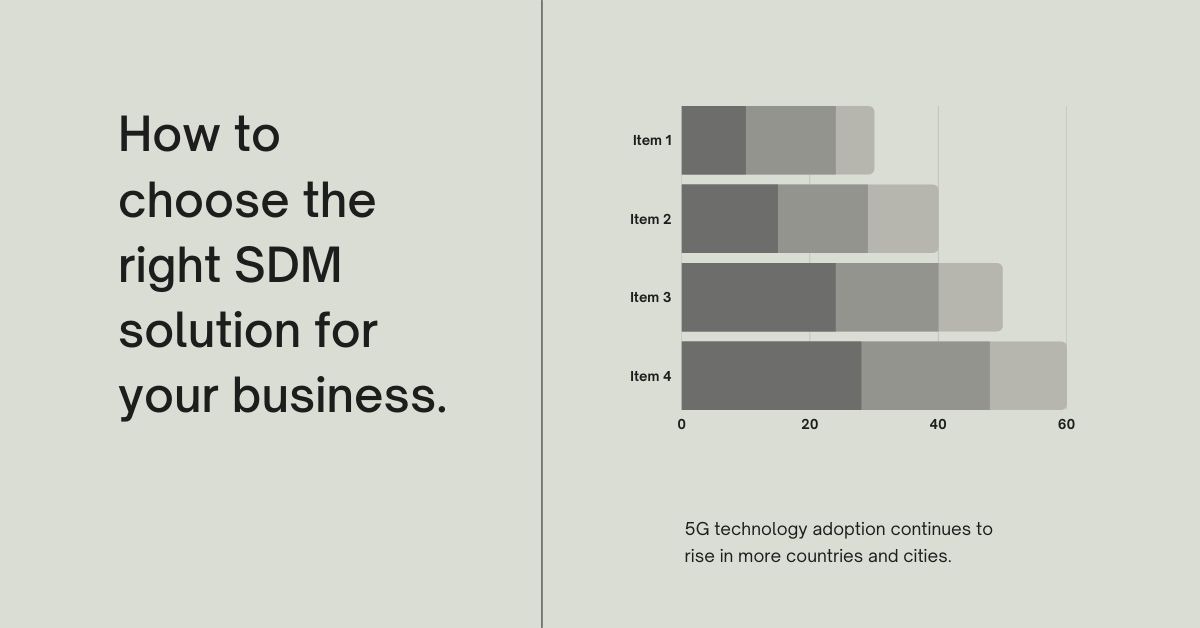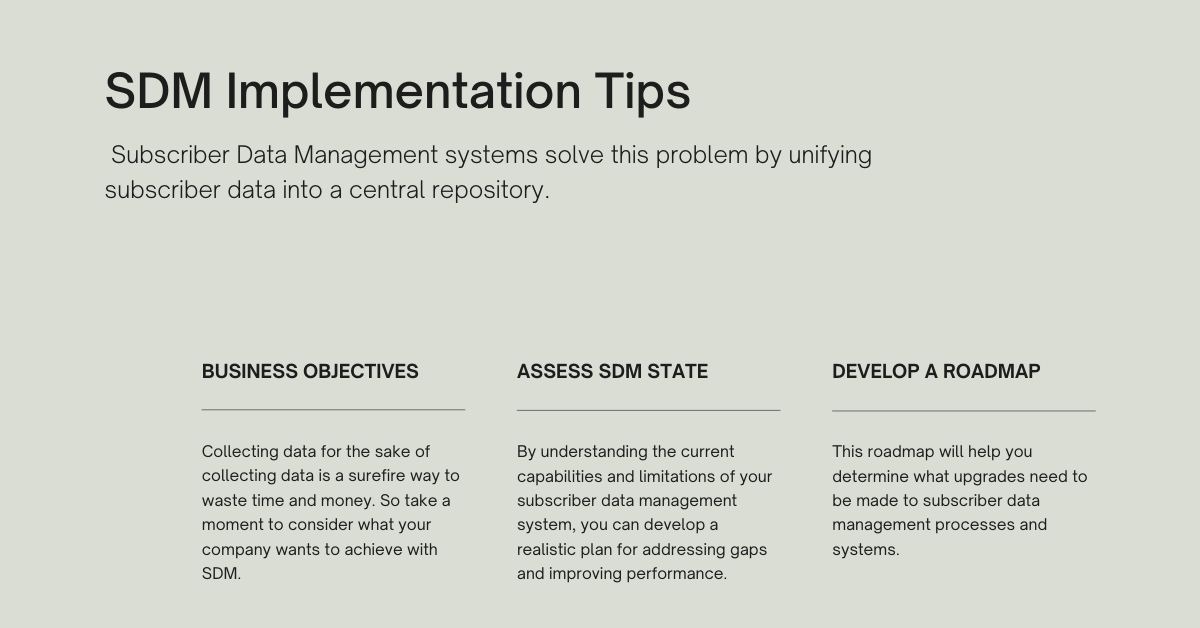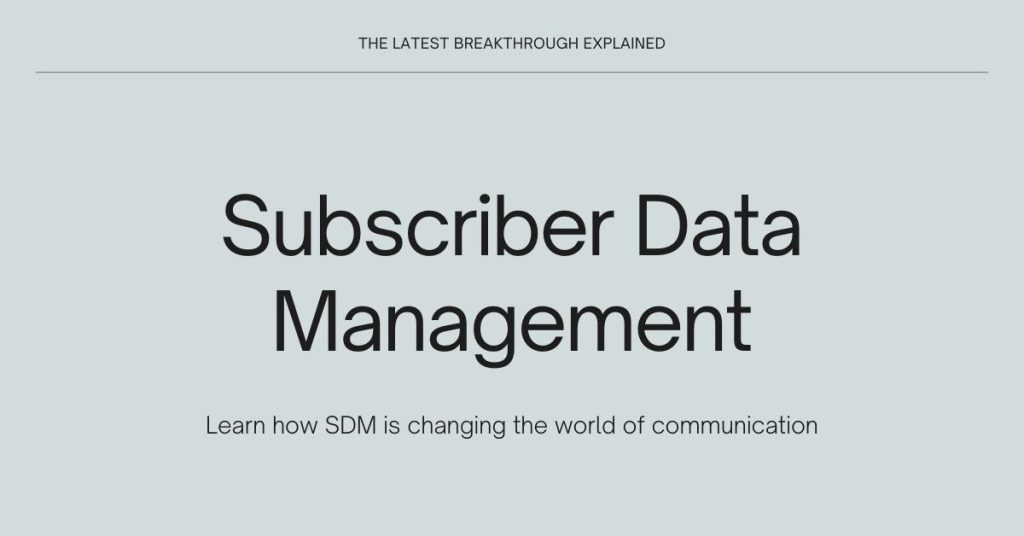The global subscriber data management (SDM) market is expected to experience exponential growth in the next few years.
It is expected to grow from $4.03 billion to $10.46 billion by 2027 at a CAGR of 17.9%. This growth is driven by the increasing investment in 5G infrastructure and the rising demand for personalized and targeted content among subscribers.
The Asia Pacific SDM market is projected to grow at the highest rate during the forecast period due to the rapid uptake of new technologies in this region.
Meanwhile, North America’s subscriber data management market is expected to hold the largest market share by 2027, owing to the presence of leading players in this region.
Now that you know subscriber data management is a big deal ,let’s take a closer look at what it is and why you should care.
What is subscriber data management (SDM)?
It’s no secret that managing subscriber data can be a daunting task. Various systems and applications contain subscriber data, and keeping track of it can quickly become overwhelming.
Subscriber Data Management (SDM) systems solve this problem by unifying subscriber data into a central repository.
With this repository, SDM solutions unify cross-domain subscriber data, including identity, location, presence, authentication, services, and access preferences. These data elements may feed multiple applications through an API interface. In other words, SDM systems make managing subscriber data much easier.
The 3GPP-defined Unified Data Repository (UDR) function is a crucial aspect of Self-service Data Management (SDM) because it enables network operators to manage data more effectively.
UDR is responsible for storing and retrieving data in 5G networks. It is a centralized system that manages data stored in different locations.
UDR provides a single point of access to data for all authorized SDM users. It also ensures that data is consistent across different 5G networks.
Benefits of subscriber data management (SDM).

Believe it or not, there are quite a few reasons telecom companies should invest in SDM – so much so that we could probably write an entire book on the topic.
But for now, we’ll focus on the top six benefits:
Cloud SW performance optimizations:
By unifying subscriber data into a central repository, SDM solutions make it easier to manage subscriber data. In turn, this leads to improved performance of cloud-based software applications.
As a result, organizations that use SDM solutions can enjoy the benefits of enhanced cloud performance without sacrificing the flexibility and scalability that have made the cloud so popular in the first place.
Simplify subscriber and services management:
Too often, telecom companies are burdened by complex, siloed systems that make managing subscriber data a real chore. But it doesn’t have to be this way.
Companies can more easily manage accounts and service offerings by consolidating subscriber data into a single view. This not only saves time and money but also makes for happier customers.
Telecom businesses must do everything possible to stay ahead of the curve in today’s competitive market. Offering a streamlined customer experience is one way to do just that.
Innovate rapidly with open programmability capabilities:
If you’re looking to innovate rapidly, you’ll want to find a software-defined networking (SDN) solution with an open application programming interface (API). This will allow you to integrate the SDN into your existing systems easily.
And once you’ve done that, the sky’s the limit regarding what you can do with it.
For example, you could use the SDN to improve customer service or develop new products and services. Alternatively, you could use it to reduce operating costs or increase network capacity.
Consolidated view of all real-time subscriber data:
Telecom companies have a lot of data to keep track of from subscriber phone numbers, addresses, account balances, and usage history. And that’s just the tip of the iceberg.
This data is often spread across different systems to complicate things.
A subscriber data management system consolidates all this data into a single access point to make it easy to track subscriber activity in real time.
No more hunt and peck!
Multi-domain, vendor, and application system:
SDM solutions are designed to work with various systems and applications to make it easier to manage subscriber data across multiple domains, including customer relationship management (CRM), billing, and operations support systems (OSS).
In addition, SDM solutions can be deployed in both on-premise and cloud environments to give you the flexibility to choose the deployment option that best fits your needs.
Highly resilient carrier-grade solution:
SDM solutions are the perfect way to get ahead in the telecom world. Not only are they specifically designed to meet the needs of telecom companies, but they’re also easily integrated into existing infrastructure.
Their real-time data synchronization is perfect for keeping your subscriber base accurate and up-to-date. In other words, SDM solutions are ideal for anyone who wants to give their telecom company a competitive edge.
Now that we’ve covered the basics of subscriber data management, let’s take a closer look at the different types of SDM.
Types of subscriber data management.
There are two main types of subscriber data management:
- Legacy subscriber data architecture
- Next-generation SDM solutions
Legacy subscriber data architecture:
This type of subscriber data management was designed to work with legacy systems.
While it may be compatible with newer systems, it is not as flexible or scalable as next-generation SDM solutions.
Next-generation SDM solutions:
This type of subscriber data management is designed to work with legacy and new systems.
It is more flexible and scalable than legacy subscriber data management, making it the perfect solution for telecom companies looking to consolidate their subscriber data.
How to choose the right SDM solution for your business.

So, what’s the best subscriber data management solution for your business?
The answer to this question depends on several factors, including:
The policy data:
When choosing an SDM solution, the policy data should be in your mind. The policy data is the subscriber’s information to ensure they follow the network’s rules and regulations. It includes their phone numbers, addresses, account balances, and usage history.
Not only does it help the network operator ensure that subscribers are behaving, but it also allows them to identify anyone abusing the system and take action accordingly.
Without this data, the network would be a free-for-all, and subscribers could use it however they pleased. So when you’re looking at SDM solutions, be sure to consider the importance of the policy data.
Service authorization:
When you sign up for a new service, the first thing they always make you do is go through an authorization process. This process is designed to help the company verify your identity and make sure you are who you say you are.
It also allows the company to check your creditworthiness and see if you are a reasonable risk.
Service authorization is vital in protecting subscribers from fraud and identity theft. Without it, anyone could sign up for a service and use it without consequences.
Service activation:
What good is having a sexy new service if your customers can’t use it?
Activating a subscriber’s service is called “service activation.” It includes provisioning the subscriber’s service and assigning them a phone number.
Provisioning is the technical term for setting up the service, and it usually involves configuring the network so that the subscriber can access it.
Assigning a phone number is pretty self-explanatory – the subscriber is given a phone number that they can use to make and receive calls.
So when you’re looking at SDM solutions, be sure to ask about their service activation process. You want to be sure that your customers can use your services.
Deprovisioning:
Deprovisioning is the process of deactivating a subscriber’s service and is an essential part of customer churn management. This process includes revoking the subscriber’s service and releasing the subscriber’s phone number.
By automating the de-provisioning process, you can improve customer satisfaction by ensuring that customers cannot continue using your service after they cancel their subscriptions.
In addition, automated de-provisioning can help reduce operational costs by eliminating the need for manual processes.
Application state policy:
As any savvy shopper knows, it’s essential to read the fine print when looking for a product or service. The same is true when choosing an SDM solution.
Before signing on the dotted line, be sure to give serious consideration to the application state policy. This policy dictates how subscriber data is used to manage the state of subscriber applications.
In other words, it includes everything from phone numbers and addresses to account balances and usage history. This critical information should be handled with care, and you’ll want to be sure that your SDM solution has a robust, secure policy.
Don’t get caught blindsided by an unexpected data breach – choose wisely and prioritize application state policy.
Data Enrichment:
Any business’s success is only as good as the data it has to work with. That’s why, when choosing an SDM solution, data enrichment should be top of mind.
Data enrichment is the process of adding subscriber data to an existing database. This process can be used to add subscriber phone numbers, addresses, and account balances to a customer database.
By enriching your data, you’ll be able to understand your subscribers better, target your marketing efforts, and provide personalized customer service.
So don’t skimp on data enrichment – it could be the key to unlocking your company’s true potential.
Identity Authentication:
In today’s world, ensuring your safe and secure identity is more critical than ever. That’s why, when choosing an SDM solution, you should always keep identity authentication top of mind.
Identity authentication is verifying a subscriber’s identity, and it’s essential for keeping your personal information safe. The process includes verifying the subscriber’s name, address, and date of birth.
By ensuring the subscriber’s identity is correctly authenticated, you can rest assured that your information is safe and sound.
So when choosing an SDM solution, be sure to choose one that offers robust identity authentication. It’s the best way to protect yourself in today’s digital world.
SDM Implementation tips and best practices.

Now that you know all about subscriber data management, it’s time to put that knowledge into practice. Here are a few tips and best practices to help you get started:
Define the business objectives and requirements:
Before collecting subscriber data, you must define the business objectives and requirements to help you determine what subscriber data needs to be collected and managed.
Collecting data for the sake of collecting data is a surefire way to waste time and money. So, take a moment to consider what your company wants to achieve with SDM.
Do you want to improve customer retention? Increase customer lifetime value? Reduce customer churn?
Once you’ve defined your goals, you can start collecting the data to help you achieve them.
Assess the current state of subscriber data management:
It’s important to take stock of what you have before you can plan for what you need. That’s why an assessment of the current state of subscriber data management is an essential part of any improvement effort.
By understanding the current capabilities and limitations of your subscriber data management system, you can develop a realistic plan for addressing gaps and improving performance.
With a clear understanding of the challenges and opportunities presented by subscriber data management, you can make sound decisions that will help your business achieve its goals.
Develop a roadmap for upgrading subscriber data management capability:
After you’ve assessed the current state of subscriber data management, it’s time to develop a roadmap for upgrading subscriber data management capability.
This roadmap will help you determine what upgrades need to be made to subscriber data management processes and systems.
The first step is to identify the specific areas that need improvement and then develop a plan for making the upgrades. This plan should consider both your short-term and long-term needs.
As you develop the plan, consult with stakeholders to get their input and buy-in. Once the plan is finalized, it’s time to implement the upgrades. This process will require close collaboration between IT and business teams.
Implementing the upgrades will likely be a multi-phase process, so be sure to understand the timeline and milestones before getting started clearly.
Manage the transition to an upgraded SDM system:
The first step in managing the transition to an upgraded subscriber data management system is ensuring that all subscriber data is correctly migrated to the new system.
This might seem daunting, but it’s pretty simple: ensure that all of your data is properly backed up and that you have a clear plan for moving it over to the new system.
Once you’ve taken care of that, it’s time to start testing the new system to ensure everything works. This step will also help you identify potential problems before they cause any major issues.
Once you’re satisfied that the new system is working correctly, you can finally start using it for your subscriber data management needs. Congratulations – you’ve successfully transitioned to an upgraded subscriber data management system!
Evaluate results and optimize the SDM process:
Now that the subscriber data management system has been upgraded, it’s time to evaluate how well it’s working and identify ways to improve it.
The evaluation should consider how well the system integrates with other systems, how accurate and complete the data is, how easy it is to use, and how well it supports business processes.
Based on the evaluation, adjustments can be made to improve the subscriber data management process.
For example, if the data is inaccurate or incomplete, steps can be taken to improve data quality. Training can be provided if the system is difficult to use, or the user interface can be redesigned.
Ensure data quality and governance throughout the SDM process:
There’s nothing worse than having insufficient data. It’s like having a bunch of dirty clothes – it’s just a pain to deal with.
But just like you need to do laundry regularly, you also need to ensure data quality and governance in your subscriber data management process. This way, you can be sure that your subscriber data is accurate and up-to-date.
Plus, it’ll save you many headaches in the long run. So don’t wait until your data is a mess – start keeping it clean from the beginning.
Review and update SDM processes regularly:
As anyone in the customer service industry knows, one of the most important things you can do is keep your data management processes up-to-date.
After all, if your subscriber data management processes are out-of-date, you risk losing customers. And nobody wants that!
Instead, regular reviews and updates will help ensure that your data management processes are current and accurate.
Not to mention, it’ll also help you keep your customers happy. So don’t wait: review and update your SDM processes today.
The future of Subscriber Data Management.
With the ever-growing popularity of mobile devices and data usage, network carriers are looking for ways to improve their subscriber data management.
To keep up with the demand, they need to find a solution to handle the large amounts of data generated daily. One way to do this is by using a cloud-based solution.
Cloud-based solutions offer many benefits for network carriers. They are scalable, so they can easily handle increases in data volume.
They are also flexible, so carriers can customize the solution to meet their specific needs.
In addition, cloud-based solutions are typically more cost-effective than traditional on-premises solutions.
Network carriers looking to improve their subscriber data management should consider a cloud-based solution.
Cloud-based solutions offer scalability, flexibility, and cost-effectiveness, essential for managing large amounts of data.
When choosing a solution, carriers should select one that meets their specific needs.
With the right solution in place, carriers can improve their subscriber data management and keep up with the demands of the mobile world.
Final thoughts:
Subscriber data management is essential for businesses to keep up with the demands of the mobile world.
Businesses can use a cloud-based subscriber data management solution to improve and keep up with the service demands.
When choosing a subscriber data management solution, it is vital to select one that meets the specific needs of your business.
With the right solution in place, you can improve subscriber data management and keep up with the demands of mobile world technology.
Did you find this article helpful? Let us know in the comments below!




